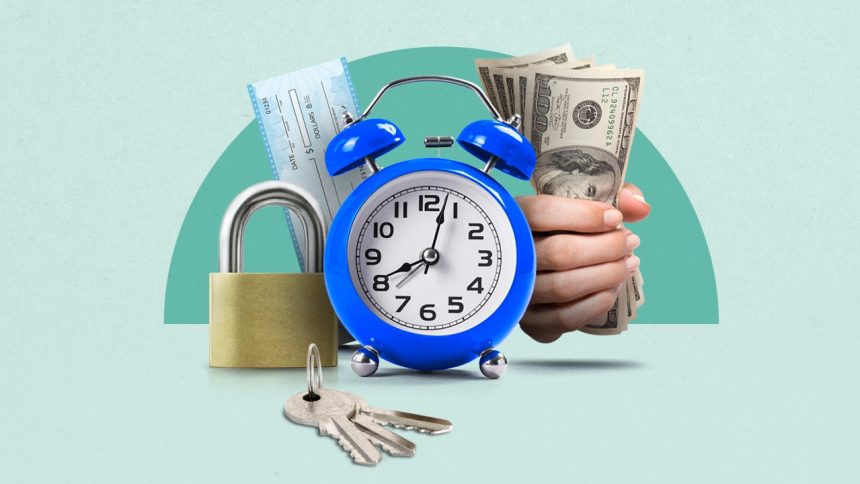Our writers and editors used an in-house natural language generation platform to assist with portions of this article, allowing them to focus on adding information that is uniquely helpful. The article was reviewed, fact-checked and edited by our editorial staff prior to publication.
Key takeaways
- A CD locks in your money for a set period of time, also known as a term, in exchange for providing a guaranteed yield on the funds.
- CDs are offered in terms that typically range from three months to five years, but can be as short as one month to as long as 10 years or more. When choosing a term, consider when you’ll need access to the money.
- If you need to withdraw your money before a CD’s term is up, the bank will likely charge you an early withdrawal penalty that eats away at your interest (and sometimes the principal).
A certificate of deposit (CD) is a low-risk deposit account that earns a fixed rate of return. In exchange for this guaranteed yield, you agree to lock up your money until the CD’s term expires. CDs are best used for money you won’t need before the term is up. Accessing the money prior to that results in an early withdrawal penalty.
What is a CD?
A CD is a type of account offered by banks and credit unions that pays interest on your money for a set period of time. These accounts pay a guaranteed rate of return. CDs sometimes offer a better annual percentage yield (APY) than traditional savings accounts, although the gap isn’t as wide as it once was.
If you visit a brokerage firm, you’ll find that some of them also offer CDs from different financial institutions.
How CDs work
A CD locks in your money for a set period of time in exchange for a guaranteed APY. Understanding all the features of a CD can help you decide whether one is right for you:
- Term: When you open a CD, you have to select a term, which is the length of time the money remains in the account. For example, if you open a CD with a one-year term, you agree to keep your money in the account for one year. After the CD’s term ends, the CD matures and you may either withdraw the money or renew the CD.
- Early withdrawal penalty: Early withdrawals from a traditional CD could incur a stiff penalty that eats into interest earnings and sometimes part of the principal. The longer the term of the CD, the heftier the fee tends to be. Typically the fee is calculated based on a specified number of days’ worth of interest.
- APY: The APY is your CD’s rate of return. The higher the APY of the CD, the more interest it will earn. Typically, CDs compensate for their reduced flexibility compared to savings accounts with higher rates.
- Minimum opening deposit: Some banks don’t require any set minimum deposit when you open your CD, while others may require amounts such as $500, $2,500 or more. Unlike a savings account, you’re not able to add more funds to a CD once you’ve opened it.
- Grace period: Once a CD matures, the bank will give you some time to either withdraw your money or roll it into a new CD. Often, the grace period is between five and ten days. If you make no changes during the grace period, most banks will automatically roll the balance into a new CD.
Why should you consider getting a CD?
CDs are a low-risk place to stash cash and get a guaranteed rate of return. That makes them good investments for short- to medium-term goals, like saving for a new car or for a down payment on a home.
Because there’s generally a penalty for making an early withdrawal from a CD, it’s also a good place to store money you want to keep from touching for a specific amount of time. You may earn more than you would through a standard savings account, too.
However, a CD isn’t necessarily the best option for everyone or every circumstance. Minimum deposits for CDs can be higher than the ones tied to savings accounts. A CD also might not be the best option if you need the money for an emergency. In that case, you’re better off keeping the money in an account with more liquidity, like a savings or money market account.
Though they may earn more interest than savings accounts, CDs are still a low-risk investment, and therefore they have lower yields than what could be earned by putting money in the stock market. To earn a higher rate of return, aim for a riskier investment.
How to choose a CD
If you think that opening a CD is right for you, it’s a good idea to sit down and think carefully about which CD you should open. Consider these factors:
- The CD term. Start by thinking about how long the CD’s term should be because this will impact other aspects of your decision. Remember that your money is locked in the CD for the full length of the term, so choose a term that lines up with when you’ll need the money back.
- Consider unique features. Some banks offer CDs with unusual features. For example, Ally Bank offers a “Raise Your Rate” CD which lets you boost the rate of the CD once or twice during its term so long as market rates have risen since the account was opened. Some unique CD features may appeal depending on your goals.
- Minimum deposit. Banks typically require a minimum deposit before you can open an account. The minimum can range widely, with some banks having very high requirements. Make sure you can meet the minimum deposit before you get too attached to a specific CD.
- Interest rate. Based on your desired CD term, features, and the minimum deposit requirements you can meet, look for the CD with the higher available rate. Remember, the higher the APY of the CD, the more interest you’ll earn.
- Early withdrawal penalty. While you shouldn’t plan for an early withdrawal, if two CDs are very similar, check to see what penalty each charges if you do make an early withdrawal. Opting for the account with the lower penalty could save you some cash if something unexpected happens.
What happens when a CD matures?
When a CD matures, it enters a grace period. This is the period of time where you have the opportunity to make changes to the account, whether that’s withdrawing your money, depositing more, or rolling the balance into a new CD, either with the same or a different term.
Depending on the bank, the CD’s grace period usually lasts between five and ten days.
If you make no changes during the grace period, the bank will usually roll the CD’s balance into a new CD with the same term as the previous one. The interest rate of the new CD will be whatever the current rate the bank offers is, which may be higher or lower than the previous CD’s rate.
Once the grace period ends and the bank opens a new CD for you, you’ll be subject to early withdrawal penalties if you want to make any changes. That makes it very important to keep an eye on your CDs’ maturity dates, lest your money get trapped in a CD for longer than you planned.
Pros and cons of CDs
Pros
- Safety: CDs are insured at banks that are members of the Federal Deposit Insurance Corp. (FDIC) and at credit unions insured by the National Credit Union Administration (NCUA) for up to $250,000 per account owner, per bank, per account type.
- Predictability: You’ll get a guaranteed rate of return.
- Higher APYs: CDs can offer higher APYs than traditional savings or money market accounts.
- Options: There are several different types of CDs for various financial needs, as well as many term options.
- Availability: CDs are widely available from traditional banks, credit unions and online banks.
Cons
- Liquidity: CDs lack liquidity, requiring that you lock away your money for a set period of time.
- Penalties: CDs often have stiff penalties for withdrawing money before the maturity date.
- Risk: Some CDs, such as callable CDs, are riskier than other types. Early withdrawal penalties also pose a risk.
- Taxes: You’ll pay taxes on interest that accumulates in your CD during the term.
- Lower returns: CDs don’t offer returns as high as some other investments, like stocks or bonds.
CDs vs. savings accounts
CDs and traditional savings accounts both help you save money and earn interest, but choosing between them can be difficult. Each is useful for different purposes.
- Savings accounts are a better place for funds you might need to access at a moment’s notice. That’s because you typically can withdraw money from a savings account up to six times a month without a fee. This makes savings accounts good for holding an emergency fund or money for very short-term goals. CDs, on the other hand, usually charge an early withdrawal penalty when you need to access the funds before the term is up.
- CDs can be a better place for funds you won’t need in the near future. Because you lock the funds in, a CD can help keep you from spending money on impulse purchases.
- Savings account APYs can change over time, whereas CDs earn a fixed APY. Whether a variable or fixed APY is better depends on the current rate environment. Having a variable rate can be advantageous at a time when rates are increasing, while having a fixed rate can be better when rates are falling.
Ultimately, if you’re looking for quick and easy access to your funds, consider keeping your money in a traditional savings account. If you have some money that you’re willing and able to part with for a set amount of time, consider a CD.
How to build a CD ladder
A CD ladder is a strategy in which you purchase multiple CDs with different maturity dates. Laddering CDs can reduce risk and allow an investor to have access to cash at regular intervals while still taking advantage of higher interest rates.
First decide how much you’d like to save and how often you want money to become available from matured CDs.
As an example, let’s say you want to build a five-year ladder with five rungs. If you have $5,000 to invest, you could place $1,000 in each rung. It would look like this:
With this setup, a CD would mature each year, and the CDs with the longer terms would likely yield the highest returns — although that’s not necessarily the case in the current CD rate environment.
One way to extend the ladder even further is by rolling the money from a CD that has just matured into a new five-year CD.
Use Bankrate’s CD ladder calculator to help build a CD ladder that fits your budget and timeline.
Types of CDs
While all types of CDs involve stashing money away for a designated term, some CDs come with added features or more flexibility. The different types are:
- Traditional CDs
- Traditional CDs, the most common type of CDs, feature a fixed APY and a fixed term. You’ll get hit with a penalty for withdrawing money early.
- No-penalty CDs
- These CDs, also known as liquid CDs, offer the ability to withdraw money early without paying a penalty. They often have lower rates than traditional CDs with the same term.
- Bump-up CDs
- If rates rise during the CD term, bump-up CDs give you the option of a once-per-term rate increase.
- Step-up CDs
- Like bump-up CDs, step-up CDs offer the ability to increase your rate in a rising-rate environment. The difference is that step-up CDs offer automatic increases at certain intervals.
FAQs about certificates of deposit
-
Choosing a CD term should be based on when you’ll need access to the money. For instance, if you plan to go on vacation in a year, a one-year CD could be a good term to go with. If you plan to buy a house in three years, then a three-year term could be right for you. Longer-term CDs may have higher APYs than shorter-term ones, although this isn’t always the case.
-
One factor that can affect CD rates is changes to the federal funds rate, which is the Federal Reserve’s benchmark rate. When this rate goes up, competitive banks increase their APYs, and when the rate goes down, they tend to lower their rates, in turn. Another factor that often affects CD rates is competition among banks as they try to win over customers from other banks through higher yields.A CD’s term may also affect its rate, since historically, banks have often paid higher rates to customers willing to lock in their funds in CDs for longer terms. However, today many banks are paying higher yields on one-year CDs than five-year ones, for instance. As such, it pays to compare rates among terms before choosing the one that’s best for you.
-
Types of CDs include traditional CDs, no-penalty CDs, jumbo CDs, bump-up CDs, step-up CDs, zero-coupon CDs, callable CDs and IRA CDs.
-
CDs are very safe, so it’s hard to lose money on them. They’re fully insured by the FDIC up to the $250,000 per depositor, per bank limit, so even if the bank fails, you’ll be reimbursed so long as your balance remains under $250,000. The main way to lose money on a CD is by making a withdrawal early in the CD’s term. If the withdrawal comes early enough, the penalty may be large enough to cost all of the interest you’ve earned as well as some principal.
Bottom line
Overall, CDs are safe investments found at banks and credit unions offering a guaranteed rate of return. You have to keep your money locked up for a set period of time, but in exchange, you’ll often get a higher rate than you would with a traditional savings or money market account.
In a high-rate environment, the reward for saving your money in a CD is even greater, and you’re guaranteed to earn that high rate for the duration of the term.
–Freelance writer TJ Porter contributed to updating this article.
Read the full article here
















